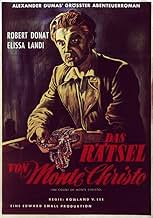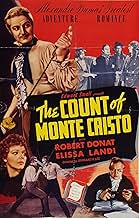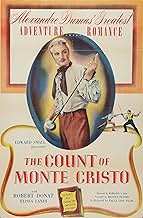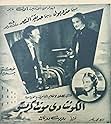AVALIAÇÃO DA IMDb
7,4/10
3,6 mil
SUA AVALIAÇÃO
Adicionar um enredo no seu idiomaAfter greedy men have Edmond Dantes unjustly imprisoned for 20 years for innocently delivering a letter entrusted to him, he escapes to get his revenge on them.After greedy men have Edmond Dantes unjustly imprisoned for 20 years for innocently delivering a letter entrusted to him, he escapes to get his revenge on them.After greedy men have Edmond Dantes unjustly imprisoned for 20 years for innocently delivering a letter entrusted to him, he escapes to get his revenge on them.
- Direção
- Roteiristas
- Artistas
- Prêmios
- 3 vitórias no total
Avaliações em destaque
I was lucky enough to obtain a video copy of an excellent black & white print of this movie, as I believe the colourisation of current copies falsifies the viewing experience. The photography and lighting are so exquisite, only the 1930's movie-making artists - it was an art form then - could accomplish it and it has to be appreciated like an antique: old, but immensely valuable for that.
They truly don't make them like this any more, and after having seen some of the subsequent screen versions, I still don't believe this one has ever been surpassed. I have also read Dumas' novel and would say that except for some minor alterations to the plot, the movie is largely true to the book.
Robert Donat is a dashing Dantes, whose ageing in body and spirit during the course of the movie is utterly believable (but he even improved on his ability to portray a physical and mental journey a few years later, when he made "Goodbye Mr. Chips"). Elissa Landi is a sweet and witty heroine, and the villains are so beautifully characterised (notably Sidney Blackmer's Mondego) that it becomes all the more satisfying when Dantes deals with them according to their own villainous traits.
I particularly enjoyed the intelligent flashes of irony with which the grim story is suffused, such as Dantes' double-speak as he flatters his enemies, at the same time telling them truth which they choose to misunderstand. The script is fantastic, the acting luminous. I feel sorry for those who hesitate to watch black & white classics like this one - they miss out on the very essence of what the art of movie-making and acting really used to be about.
They truly don't make them like this any more, and after having seen some of the subsequent screen versions, I still don't believe this one has ever been surpassed. I have also read Dumas' novel and would say that except for some minor alterations to the plot, the movie is largely true to the book.
Robert Donat is a dashing Dantes, whose ageing in body and spirit during the course of the movie is utterly believable (but he even improved on his ability to portray a physical and mental journey a few years later, when he made "Goodbye Mr. Chips"). Elissa Landi is a sweet and witty heroine, and the villains are so beautifully characterised (notably Sidney Blackmer's Mondego) that it becomes all the more satisfying when Dantes deals with them according to their own villainous traits.
I particularly enjoyed the intelligent flashes of irony with which the grim story is suffused, such as Dantes' double-speak as he flatters his enemies, at the same time telling them truth which they choose to misunderstand. The script is fantastic, the acting luminous. I feel sorry for those who hesitate to watch black & white classics like this one - they miss out on the very essence of what the art of movie-making and acting really used to be about.
Delightful film of the classic stage warhorse, a bit creaky and slow starting, but with cumulative power sustained by the subtle yet vivid characterizations. Each principal has a uniquely nuanced personality, brought forth by gesture and language -- something sorely lacking in today's 90 percent trash. NOTE FOR CINASTES: I never fully appreciated the comic outrages of Jame's Whale's use of the Hermit in Bride of Frankenstein until I saw the prototype, created here by the same actor, O. P. Heggie. The Hermit in "Bride" is a gleeful, unabashed parody of Faria, even in the crescendo of music that mimics the "Ave Maria" in the Whale picture. I'm sure Whale wondered if his in-joke would be caught, and by how many. See the picture and you'll understand.
THE COUNT OF MONTE CRISTO (United Artists/Reliance, 1934), directed by Rowland V. Lee, from the immortal novel by Alexandre Dumas, and personally supervised by Edward Small, capitalized on the current trend of literary works adapted to the motion picture screen. It stars British import Robert Donat, making his Hollywood debut, in fact, his only one as a leading performer on U.S. soil. He would spend the duration of his career in British-made productions, thus, later winning an Academy Award as best actor in another memorable performance in GOODBYE, MR. CHIPS (MGM, 1939) opposite Greer Garson.
For the benefit of those unfamiliar with either the book or the motion picture(s), here is a brief summary: The story, which begins in 1815, finds Edmund Dantes (Robert Donat) a young sailor on a French ship who has honored the dying request of his captain, LeClere (William Farnum), to carry a private letter to Napoleon on Elba. While ashore, he meets with Mercedes De Rosas (Elissa Landi), the woman he loves. Because Fernand (Sidney Blackner) loves Mercedes, he, along with others in his scheme, succeed to have Dantes arrested for carrying a secret letter and for this reason, unjustly imprisoned in the Château d'If. While in prison, Dantes is treated harshly and cruely by the guards, and Mercedes, although still in love with Dantes, finds herself marrying Fernand, later to bear him a son. Later, Dantes encounters Abbe Faria (O.P. Heggie), an old man imprisoned there for many years who spends his free time cutting his way through prison walls and digging a tunnel that would someday get him through to freedom. Over the years, Abbe Faria educates his friend Dantes by showing him a chart of the location of fabulous treasure on the island of Monte Cristo. While digging through the tunnel, there is a cave-in that crushes Abbe Faria's ribs, later the cause of his death. As the guards prepare to take the old man's body away, Dante switches places with the deceased, and hides himself in the burial sack. After being thrown into the ocean, Dantes breaks himself free.He is then rescued and picked up by Captain Camp (Mitchell Lewis), who makes him part of his crew. After shaving off his long beard, Dante locates the island of Monte Cristo and he goes ashore to possess the treasure, making him a very rich man. He then returns to France in the guise of The Count of Monte Cristo to then avenge his three enemies, Fernand, Raymond DeVillefort (Louis Calhern) and Danglars (Raymond Walburn), the men who had him unjustly sent to prison where he stayed for twenty years. How Dantes achieves his vengeance adds to the suspense and pleasure of the avid "revenge is sweet" viewer.
Also seen in the supporting cast are Georgia Caine as Madame De Rosas; Luis ALberni as Jacopo; Clarence Muse as the muted Ali; Douglas Walton as Albert De Mondego; Juliette Compton and Lionel Bellmore, among others. The memorable musical score by Alfred Newman would be repeated in latter films, notably the "Ave Maria" underscoring portion used for LES MISERABLES (20th Century, 1935) starring Fredric March.
Hailed by many as the very best and most memorable screen adaptation to the Dumas novel, this obviously goes without question. Aside from it being faithful to the book, the movie itself holds interest throughout, and Robert Donat's performance, ranks one of his best in his long but occasional screen career. Had this movie been produced a few years later, chances are that the Dantes character would have been played by the likes of future swashbuckling kings as Errol Flynn or Tyrone Power, or even Douglas Fairbanks Jr., for example, but although Donat's Edmund Dantes is one of the best ever to be recaptured on film, asthma and ill heath would prevent him from performing similar duties in future Hollywood swashbuckling adventures.
Unfortunately, film prints to THE COUNT OF MONTE CRISTO that have circulated on television and video since the early 1980s was the abridged 97 minute version, eliminating about 20 minutes worth of footage. If one were to locate a rare video copy either at a local library or a video store, chances are they would acquire a 1990s VHS format from Video Treasures, also being a shorter and "colorized" copy. While it's hard indicate what's been actually edited, the cuts are obvious, particularly through sudden blackouts during the plot followed by fade-ins to the middle of scenes that play like reading a middle of a chapter of a book without a new beginning. Also missing from those VHS copies is the cast of actors and their roles, something that existed on TV prints prior to 1980. Restoration to the film's original length (114 minutes) and crisp black and white photography finally turned up on Turner Classic Movies on July 6, 2008.
The success of THE COUNT OF MONTE CRISTO spawned sequels "in name only" in later years, including THE SON OF MONTE CRISTO (United Artists, 1940); THE RETURN OF MONTE CRISTO (Columbia, 1946), both featuring Louis Hayward as a descendant of Edmund Dantes; among others, as well as countless remakes and imitations, but this 1934 version still should hold interest today. Rarely seen in recent years, it did have a "colorized" television presentation on the Disney Channel in the early 1990s as part of its "Best of Hollywood" program, but like the Video Treasures copy, was not the complete version.
Regardless of print availability, the 1934 first sound version to THE COUNT OF MONTE CRISTO remains an adventure classic from the "golden age of Hollywood" that has stood the test of time. (***1/2)
For the benefit of those unfamiliar with either the book or the motion picture(s), here is a brief summary: The story, which begins in 1815, finds Edmund Dantes (Robert Donat) a young sailor on a French ship who has honored the dying request of his captain, LeClere (William Farnum), to carry a private letter to Napoleon on Elba. While ashore, he meets with Mercedes De Rosas (Elissa Landi), the woman he loves. Because Fernand (Sidney Blackner) loves Mercedes, he, along with others in his scheme, succeed to have Dantes arrested for carrying a secret letter and for this reason, unjustly imprisoned in the Château d'If. While in prison, Dantes is treated harshly and cruely by the guards, and Mercedes, although still in love with Dantes, finds herself marrying Fernand, later to bear him a son. Later, Dantes encounters Abbe Faria (O.P. Heggie), an old man imprisoned there for many years who spends his free time cutting his way through prison walls and digging a tunnel that would someday get him through to freedom. Over the years, Abbe Faria educates his friend Dantes by showing him a chart of the location of fabulous treasure on the island of Monte Cristo. While digging through the tunnel, there is a cave-in that crushes Abbe Faria's ribs, later the cause of his death. As the guards prepare to take the old man's body away, Dante switches places with the deceased, and hides himself in the burial sack. After being thrown into the ocean, Dantes breaks himself free.He is then rescued and picked up by Captain Camp (Mitchell Lewis), who makes him part of his crew. After shaving off his long beard, Dante locates the island of Monte Cristo and he goes ashore to possess the treasure, making him a very rich man. He then returns to France in the guise of The Count of Monte Cristo to then avenge his three enemies, Fernand, Raymond DeVillefort (Louis Calhern) and Danglars (Raymond Walburn), the men who had him unjustly sent to prison where he stayed for twenty years. How Dantes achieves his vengeance adds to the suspense and pleasure of the avid "revenge is sweet" viewer.
Also seen in the supporting cast are Georgia Caine as Madame De Rosas; Luis ALberni as Jacopo; Clarence Muse as the muted Ali; Douglas Walton as Albert De Mondego; Juliette Compton and Lionel Bellmore, among others. The memorable musical score by Alfred Newman would be repeated in latter films, notably the "Ave Maria" underscoring portion used for LES MISERABLES (20th Century, 1935) starring Fredric March.
Hailed by many as the very best and most memorable screen adaptation to the Dumas novel, this obviously goes without question. Aside from it being faithful to the book, the movie itself holds interest throughout, and Robert Donat's performance, ranks one of his best in his long but occasional screen career. Had this movie been produced a few years later, chances are that the Dantes character would have been played by the likes of future swashbuckling kings as Errol Flynn or Tyrone Power, or even Douglas Fairbanks Jr., for example, but although Donat's Edmund Dantes is one of the best ever to be recaptured on film, asthma and ill heath would prevent him from performing similar duties in future Hollywood swashbuckling adventures.
Unfortunately, film prints to THE COUNT OF MONTE CRISTO that have circulated on television and video since the early 1980s was the abridged 97 minute version, eliminating about 20 minutes worth of footage. If one were to locate a rare video copy either at a local library or a video store, chances are they would acquire a 1990s VHS format from Video Treasures, also being a shorter and "colorized" copy. While it's hard indicate what's been actually edited, the cuts are obvious, particularly through sudden blackouts during the plot followed by fade-ins to the middle of scenes that play like reading a middle of a chapter of a book without a new beginning. Also missing from those VHS copies is the cast of actors and their roles, something that existed on TV prints prior to 1980. Restoration to the film's original length (114 minutes) and crisp black and white photography finally turned up on Turner Classic Movies on July 6, 2008.
The success of THE COUNT OF MONTE CRISTO spawned sequels "in name only" in later years, including THE SON OF MONTE CRISTO (United Artists, 1940); THE RETURN OF MONTE CRISTO (Columbia, 1946), both featuring Louis Hayward as a descendant of Edmund Dantes; among others, as well as countless remakes and imitations, but this 1934 version still should hold interest today. Rarely seen in recent years, it did have a "colorized" television presentation on the Disney Channel in the early 1990s as part of its "Best of Hollywood" program, but like the Video Treasures copy, was not the complete version.
Regardless of print availability, the 1934 first sound version to THE COUNT OF MONTE CRISTO remains an adventure classic from the "golden age of Hollywood" that has stood the test of time. (***1/2)
Alexandre Dumas' novel is a classic, and of a number of film adaptations, of which are a mixed bunch in terms of success, it's the 1934 film starring Robert Donat that I consider the best version. Maybe the editing in the escape scene is a little plodding, other than that the film is very handsomely mounted with lavish period detail and beautiful cinematography. Alfred Newman's score is suitably rousing, the story is the very definition of thrilling and never stops maintaining interest and the script is very literate and sometimes witty. The characters all engage, with the leads likable and easy to identify with and the villains suitably repellent. The swash-buckling also is never clumsy and Rowland V Lee directs beautifully. Robert Donat gives a performance that for me has only been bettered by the title role in Goodbye Mr Chips, expertly progressing from naive to calculating. Elissa Landi matches him in a sympathetic and moving performance, and Raymond Walburn is a sly Danglers, but other than Donat the other best performance is the sharp Villefort of Louis Calhern. Sidney Blackmer's Mondego is also splendidly characterised, and OP Heggie delights in a role that will remind one of the hermit in Bride of Frankenstein. Overall, wholly satisfying and definitely recommended. 9/10 Bethany Cox
Robert Donat was a fine actor who went on to win our hearts with Greer Garson in Goodbye, Mr. Chips. People often forget that he was slated to play the lead in the Sabatini novel, Captain Blood, which went to Errol Flynn, thus establishing his career and mark on Hollywood (and what a mark!). Donat, according to his biographers, detested Hollywood and made several films in Great Britain. His role in the Hitchcock 39 steps is legend. This film, which is a slightly more faithful adaptation of the Dumas book than the one only recently (1/02) released, is superior to its predecessor in several ways. Alas, the other reviewer here is likely too young to have seen in its original B/W but it is a fine film. the lovely Elissa Landi plays Mercedes and Sidney Blackmer, Donat's betrayer. The character actor, O.P. Heggie plays the priest and fellow prisoner of Dantes. Veteran Louis Calhern, here youthful, plays the other betrayer and villain. There's no video or DVD, so if this shows up on the late show, by all means, check it out.
Você sabia?
- CuriosidadesThis is the version that "V" in V de Vingança (2005) claimed to be his favorite film.
- Erros de gravaçãoDuring the fencing duel between Dantes and Mondego, in one brief shot near the end Sidney Blackmer holds his sword in his left hand instead of his right, which he does in the rest of the scene. This was obviously a shown in reverse as is often done to add footage.
- Citações
[last lines]
Albert de Mondego: [to Dantes and Mercedes who are up in the branches of a tree] Can we come up?
Edmond Dantes: Find your own tree.
- Cenas durante ou pós-créditosPrologue: "1815--Napoleon had achieved an empire and lost it again. Exhausted by years of revolution and war, France strove to make peace with her neighbors under the rule of King Louis XVIII....while the "Little Corporal," now in exile, reigned over only a few square miles of land--Elba. But the memory of his colorful career still endeared him to the hearts of the people, and his loyal followers were actively conspiring to return him to power."
- Versões alternativasAlso available in a computer-colorized version.
- ConexõesFeatured in MGM/UA Home Video Laserdisc Sampler (1990)
Principais escolhas
Faça login para avaliar e ver a lista de recomendações personalizadas
- How long is The Count of Monte Cristo?Fornecido pela Alexa
Detalhes
- Data de lançamento
- País de origem
- Central de atendimento oficial
- Idiomas
- Também conhecido como
- The Count of Monte Cristo
- Locações de filme
- Empresa de produção
- Consulte mais créditos da empresa na IMDbPro
Bilheteria
- Faturamento bruto nos EUA e Canadá
- US$ 3.270.000
- Tempo de duração1 hora 53 minutos
- Cor
- Proporção
- 1.37 : 1
Contribua para esta página
Sugerir uma alteração ou adicionar conteúdo ausente

Principal brecha
By what name was O Conde de Monte Cristo (1934) officially released in India in English?
Responda




































